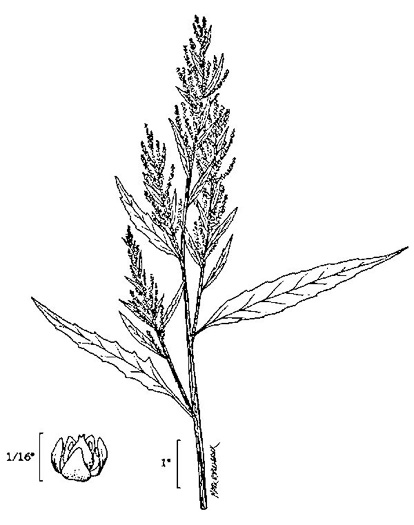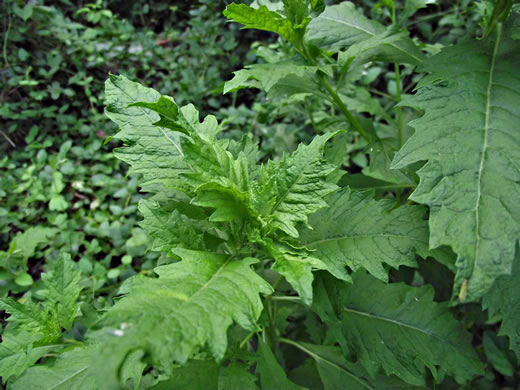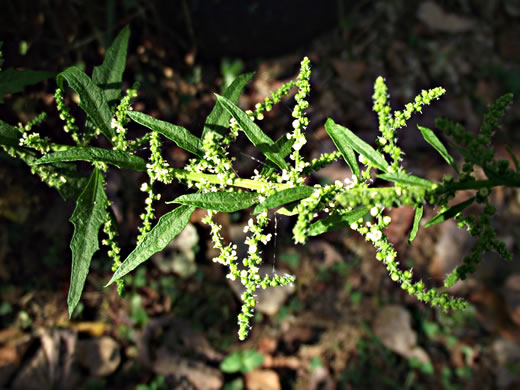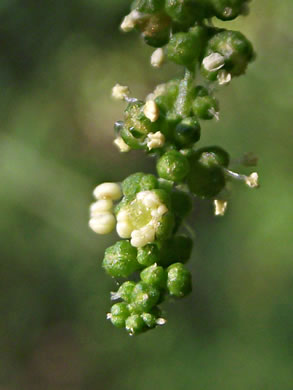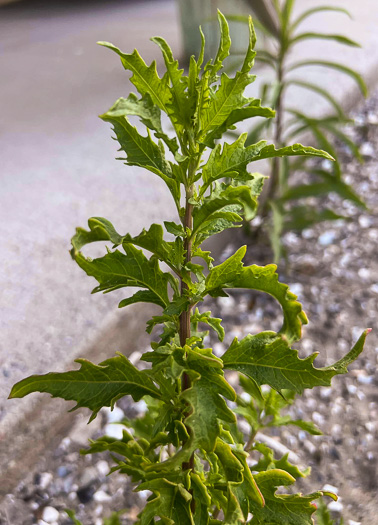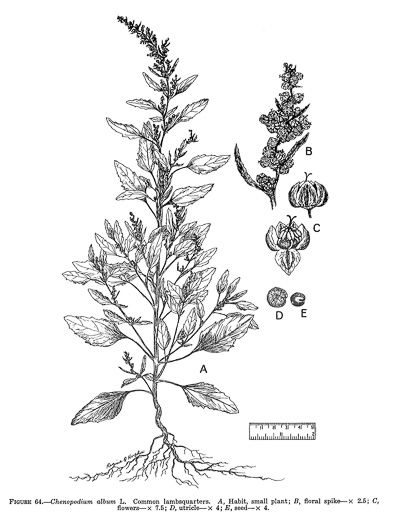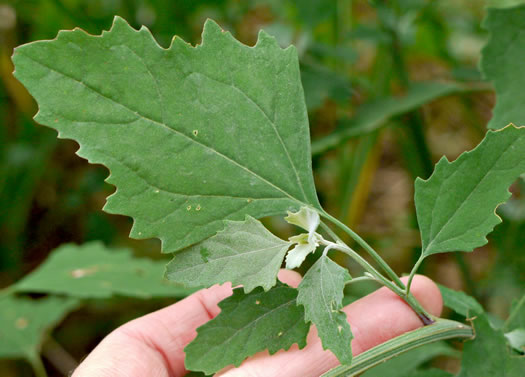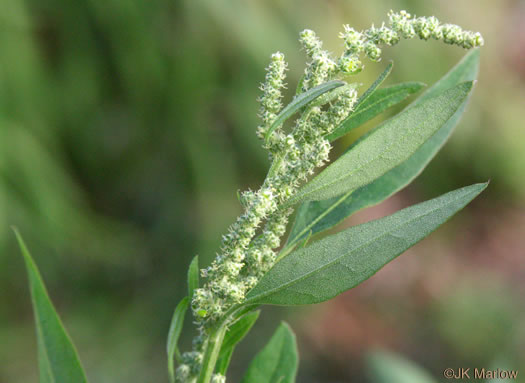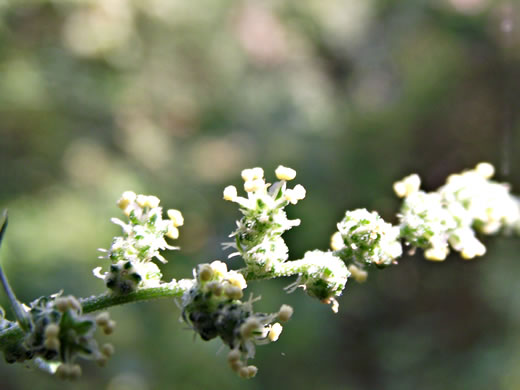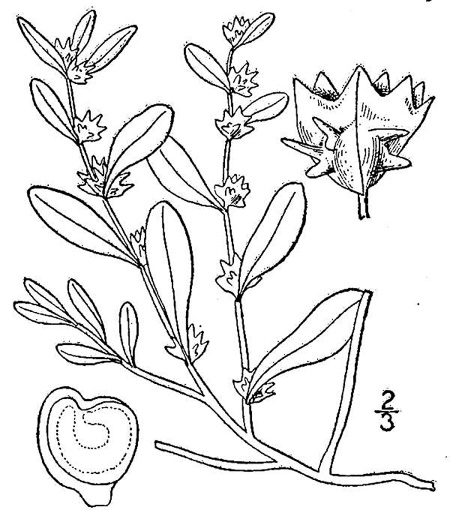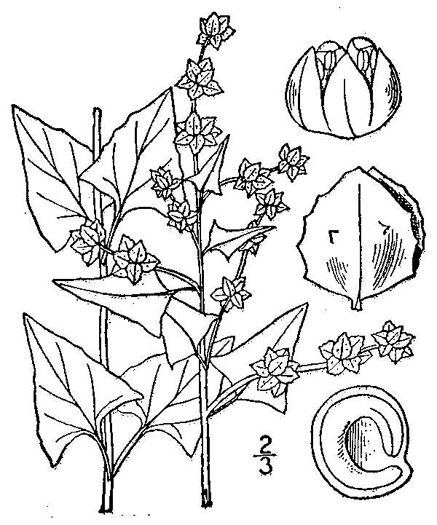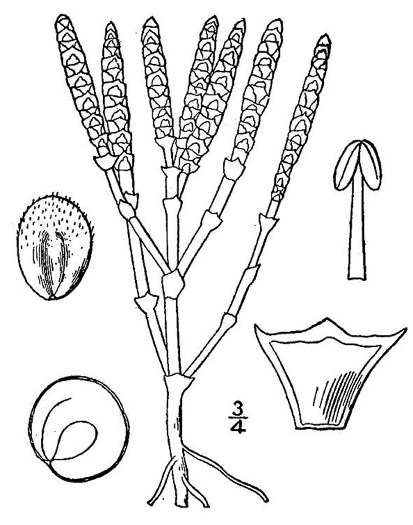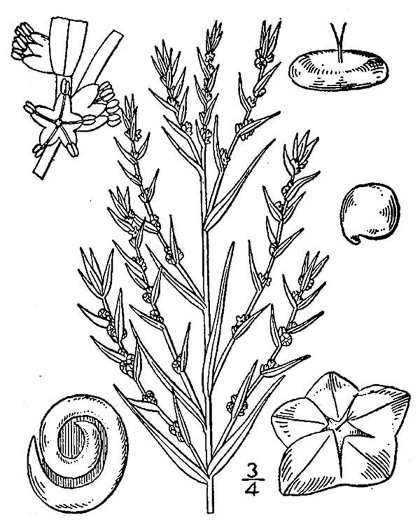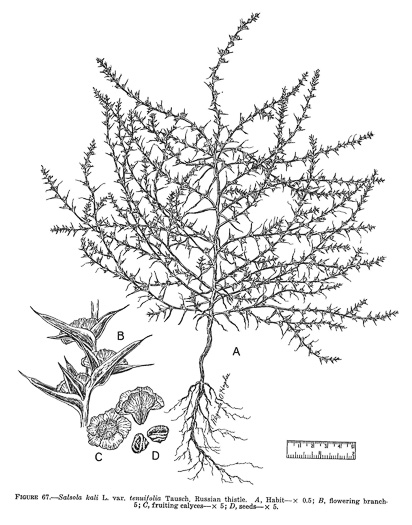Hovering over an image will enlarge it and point out features (works better on desktop than on mobile).
![]() A camera indicates there are pictures.
A camera indicates there are pictures.
![]() A speaker indicates that a botanical name is pronounced.
A speaker indicates that a botanical name is pronounced.
![]() A plus sign after a Latin name indicates that the species is further divided into varieties or subspecies.
A plus sign after a Latin name indicates that the species is further divided into varieties or subspecies.
Most habitat and range descriptions were obtained from Weakley's Flora.
Your search found 13 taxa in the family Chenopodiaceae, Goosefoot family, as understood by Weakley's Flora.

![]() Common Name:
Mexican-tea, Epazote
Common Name:
Mexican-tea, Epazote
Weakley's Flora: (4/24/22) Dysphania ambrosioides FAMILY: Chenopodiaceae
INCLUDED WITHIN PLANTS National Database: Dysphania ambrosioides FAMILY: Chenopodiaceae
INCLUDED WITHIN Vascular Flora of the Carolinas (Radford, Ahles, & Bell, 1968): Chenopodium ambrosioides 064-03-001 FAMILY: Chenopodiaceae
Habitat: Disturbed habitats; common, probably native southward
Common
Non-native? the original range unclear (probably native southwards)

![]() Common Name:
Wormseed, Epazote
Common Name:
Wormseed, Epazote
Weakley's Flora: (4/24/22) Dysphania anthelmintica FAMILY: Chenopodiaceae
(?) PLANTS National Database: Dysphania anthelmintica FAMILY: Chenopodiaceae
INCLUDED WITHIN Vascular Flora of the Carolinas (Radford, Ahles, & Bell, 1968): Chenopodium ambrosioides 064-03-001? FAMILY: Chenopodiaceae
Habitat: Dunes, also in disturbed areas
Common in Coastal Plain
Native to the Coastal Plain of the Carolinas & Georgia

![]()
![]() Common Name:
Lambsquarters, Pigweed
Common Name:
Lambsquarters, Pigweed
Weakley's Flora: (4/24/22) Chenopodium album var. album FAMILY: Chenopodiaceae
SYNONYMOUS WITH PLANTS National Database: Chenopodium album var. album FAMILY: Chenopodiaceae
INCLUDED WITHIN Vascular Flora of the Carolinas (Radford, Ahles, & Bell, 1968): Chenopodium album 064-03-002 FAMILY: Chenopodiaceae
Habitat: Disturbed soils, gardens
Common
Native & non-native

Common Name: Seabeach Orach
Weakley's Flora: (4/14/23) Atriplex pentandra FAMILY: Chenopodiaceae
INCLUDED WITHIN PLANTS National Database: Atriplex cristata FAMILY: Chenopodiaceae
INCLUDED WITHIN Vascular Flora of the Carolinas (Radford, Ahles, & Bell, 1968): Atriplex arenaria 064-04-001 FAMILY: Chenopodiaceae
Habitat: Ocean beaches, island-end flats
Uncommon
Native to the Carolinas & Georgia

Common Name: Spear Orach
Weakley's Flora: (4/24/22) Atriplex patula FAMILY: Chenopodiaceae
SYNONYMOUS WITH PLANTS National Database: Atriplex patula FAMILY: Chenopodiaceae
INCLUDED WITHIN Vascular Flora of the Carolinas (Radford, Ahles, & Bell, 1968): Atriplex patula 064-04-002 FAMILY: Chenopodiaceae
Habitat: Disturbed areas, inland saline areas
Non-native: Eurasia

Common Name: Thinleaf Orach, Fat-hen, Triangle Orach
Weakley's Flora: (4/24/22) Atriplex prostrata FAMILY: Chenopodiaceae
SYNONYMOUS WITH PLANTS National Database: Atriplex prostrata FAMILY: Chenopodiaceae
INCLUDED WITHIN Vascular Flora of the Carolinas (Radford, Ahles, & Bell, 1968): Atriplex patula 064-04-002? FAMILY: Chenopodiaceae
Habitat: Marsh edges, brackish flats
Uncommon in Carolina Coastal Plain (rare in GA)
Non-native: Eurasia?

Common Name: Dwarf Glasswort, Dwarf Saltwort
Weakley's Flora: (4/14/23) Salicornia bigelovii FAMILY: Chenopodiaceae
SYNONYMOUS WITH PLANTS National Database: Salicornia bigelovii FAMILY: Chenopodiaceae
SYNONYMOUS WITH Vascular Flora of the Carolinas (Radford, Ahles, & Bell, 1968): Salicornia bigelovii 064-05-001 FAMILY: Chenopodiaceae
Habitat: Salt pannes in coastal marshes
Common in Coastal Plain
Native to the Carolinas & Georgia

![]() Common Name:
American Glasswort, Virginia Samphire, Pickleweed
Common Name:
American Glasswort, Virginia Samphire, Pickleweed
Weakley's Flora: (4/14/23) Salicornia virginica FAMILY: Chenopodiaceae
SYNONYMOUS WITH PLANTS National Database: Salicornia depressa FAMILY: Chenopodiaceae
INCLUDED WITHIN (MISAPPLIED) Vascular Flora of the Carolinas (Radford, Ahles, & Bell, 1968): Salicornia europaea 064-05-002 FAMILY: Chenopodiaceae
Habitat: Salt pannes in coastal marshes
Common
Native to the Carolinas & Georgia

Common Name: Perennial Glasswort, Woody Glasswort, Pickleweed
Weakley's Flora: (4/14/23) Salicornia ambigua FAMILY: Chenopodiaceae
INCLUDING & INCLUDED WITHIN, APPARENTLY MISAPPLIED TO EAST COAST MATERIAL PLANTS National Database: Sarcocornia perennis FAMILY: Chenopodiaceae
(?) (MISAPPLIED) Vascular Flora of the Carolinas (Radford, Ahles, & Bell, 1968): Salicornia virginica 064-05-003 FAMILY: Chenopodiaceae
Habitat: Coastal salt marshes, primarily in salt pannes
Common
Native to the Carolinas & Georgia

Common Name: Southern Sea-blite
Weakley's Flora: (4/14/23) Suaeda linearis FAMILY: Chenopodiaceae
SYNONYMOUS WITH PLANTS National Database: Suaeda linearis FAMILY: Chenopodiaceae
SYNONYMOUS WITH Vascular Flora of the Carolinas (Radford, Ahles, & Bell, 1968): Suaeda linearis 064-06-001 FAMILY: Chenopodiaceae
Habitat: Island-end flats, marsh edges, brackish flats, shell deposits, rarely adventive inland in disturbed areas
Uncommon
Native to the Carolinas & Georgia

Common Name: Northern Saltwort
Weakley's Flora: (4/24/22) Salsola kali var. kali FAMILY: Chenopodiaceae
SYNONYMOUS WITH PLANTS National Database: Salsola kali ssp. kali FAMILY: Chenopodiaceae
INCLUDED WITHIN Vascular Flora of the Carolinas (Radford, Ahles, & Bell, 1968): Salsola kali 064-07-001 FAMILY: Chenopodiaceae
Habitat: Upper beaches, fore-dunes, and island-end flats
Rare
Generally considered to be introduced in North America but it may well be native

![]() Common Name:
Southern Saltwort, Carolina Saltwort
Common Name:
Southern Saltwort, Carolina Saltwort
Weakley's Flora: (4/24/22) Salsola kali var. caroliniana FAMILY: Chenopodiaceae
INCLUDED WITHIN PLANTS National Database: Salsola kali ssp. pontica FAMILY: Chenopodiaceae
INCLUDED WITHIN Vascular Flora of the Carolinas (Radford, Ahles, & Bell, 1968): Salsola kali 064-07-001? FAMILY: Chenopodiaceae
Habitat: Upper beaches, fore-dunes, and island-end flats, rarely inland in disturbed areas
Uncommon
Often considered to be introduced in North America but it may well be native

Common Name: Russian Thistle, Tumbleweed
Weakley's Flora: (4/24/22) Salsola tragus FAMILY: Chenopodiaceae
SYNONYMOUS WITH PLANTS National Database: Salsola tragus FAMILY: Chenopodiaceae
INCLUDED WITHIN Vascular Flora of the Carolinas (Radford, Ahles, & Bell, 1968): Salsola kali 064-07-001? FAMILY: Chenopodiaceae
Habitat: Disturbed areas
Non-native: Eurasia
Your search found 13 taxa. You are on page PAGE 1 out of 1 pages.

